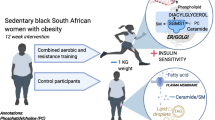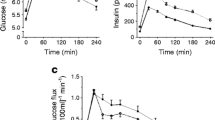Abstract
Muscle membrane fatty acid (FA) composition is linked to insulin action. The aims of this study were to compare the FA composition of muscle and erythrocyte membrane phospholipid in young children; to investigate the effect of diet on these lipid compositions; and to investigate differential incorporation of FA into muscle, erythrocyte and adipose tissue membrane phospholipid, and adipose tissue triglyceride. Skeletal muscle biopsies and fasting blood samples were taken from 61 normally nourished children (15 males and 16 females), less than 2 yr old (means ±SE, 0.80±0.06 yr), undergoing elective surgery. Adipose tissue samples were taken from 15 children. There were significant positive correlations between muscle and erythrocyte docosahexaenoic acid (DHA) (r=0.44, P<0.0001), total n−3 polyunsaturated fatty acids (PUFA) (r=0.39, P=0.002), and the n−6/n−3 PUFA ratio (r=0.39, P=0.002). Adipose tissue triglyceride had lower levels of long-chain PUFA, especially DHA, than muscle and erythrocytes (0.46±0.18% vs. 2.44±0.26% and 3.17±0.27%). Breast-fed infants had higher levels of DHA than an age-matched group of formulafed infants in both muscle (3.91±0.21% vs. 1.94±0.18%) and erythrocytes (3.81±0.10% vs. 2.65±0.23%). The results of this study show that (i) erythrocyte FA composition is a reasonable index of muscle DHA, total n−3 PUFA, and the n−6/n−3 PUFA ratio; (ii) breast feeding has a potent effect on the FA composition of all these tissues; and (iii) there is a wide range in long-chain PUFA levels in muscle, erythrocytes, and adipose tissue.
Similar content being viewed by others
Abbreviations
- DHA:
-
docosahexaenoic acid
- FA:
-
fatty acid
- LCPUFA:
-
longchain polyunsaturated fatty acids
- PUFA:
-
polyunsaturated fatty acid
References
Storlien, L.H., Pan, D.A., Kriketos, A.D., O’Connor, J., Caterson, I.D., Cooney, G.J., Jenkins, A.B., and Baur, L.A. (1996) Skeletal Muscle Membrane Lipids and Insulin Resistance, Lipids 31, S261-S265.
Storlien, L.H., Jenkins, A.B., Chisholm, D.J., Pascoe, W.S., Khouri, S., and Kraegen, E.W. (1991) Influence of Dietary Fat Composition on Development of Insulin Resistance in Rats. Relationship to Muscle Triglyceride and ω−3 Fatty Acids in Muscle Phospholipids, Diabetes 40, 280–289.
Borkman, M.B., Storlien, L.H., Pan, D.A., Jenkins, A.B., Chisholm, D.J., and Campbell, L.V. (1993) The Relation Between Insulin Sensitivity and the Fatty-Acid Composition of Skeletal-Muscle Phospholipids, N. Engl. J. Med. 328, 238–244.
Pan, D.A., Lillioja, S., Milner, M.R., Kriketos, A.D., Baur, L.A., Bogardus, C., and Storlien, L.H. (1995) Skeletal Muscle Membrane Lipid Composition Is Related to Adiposity and Insulin Action, J. Clin. Invest. 96, 2802–2808.
Reaven, G.M. (1988) Banting Lecture: Role of Insulin Resistance in Human Disease, Diabetes 37, 1595–1607.
Reaven, G.M. (1993) Role of Insulin Resistance in Human Disease (Syndrome X): An Expanded Definition, Ann. Rev. Med. 44, 121–131.
Björntorp, P. (1991) Visceral Fat Accumulation: The Missing Link Between Psychosocial Factors and Cardiovascular Disease? J. Int. Med. 230, 195–201.
Baur, L.A., O’Connor, J., Pan, D.A., Kriketos, A.D., and Storlien, L.H. (1998) The Fatty Acid Composition of Skeletal Muscle Membrane Phospholipid: Its Relationship with the Type of Feeding and Plasma Glucose Levels in Young Children, Metabolism 47, 106–112.
Pan, D.A., and Storlien, L.H. (1993) Dietary Lipid Profile Is a Determinant of Tissue Phospholipid Fatty Acid Composition and Rate of Weight Gain in Rats, J. Nutr. 123, 512–519.
Folch, J., Lees, M., and Sloane-Stanley, G.H. (1957) A Simple Method for the Isolation and Purification of Total Lipids from Animal Tissues, J. Biol. Chem. 226, 497–509.
World Health Organization (1983) Measuring Change in Nutritional Status, Geneva, World Health Organization, pp. 61–101.
Dibley, M.J., Staehling, N.W., Nieburg, P., and Trowbridge, F.L. (1987) Interpretation of Z-score Anthropometric Indicators Derived from the International Growth Reference, Am. J. Clin. Nutr. 46, 749–762.
National Food Authority (1991) NUTTAB91-19: Nutrient Data Table for Use in Australia, A.G.P.S., Canberra.
Makrides, M., Simmer, K., Neumann, M.A., and Gibson, R.A. (1995) Changes in the Polyunsaturated Fatty Acids of Breast Milk from Mothers of Full-Term Infants over 30 Weeks of Lactation, Am. J. Clin. Nutr. 61, 1231–1233.
Koletzko, B., and Bremer, H.J. (1989) Fat Content and Fatty Acid Composition of Infant Formulas, Acta Paediatr. Scand. 78, 513–521.
Jackson, K.A., and Gibson, R.A. (1989) Weaning Foods Cannot Replace Breast Milk as Sources of Long-Chain Polyunsaturated Fatty Acids, Am. J. Clin. Nutr. 50, 980–982.
Farquharson, J., Cockburn, F., Patrick, W.A., Jamieson, E.C., and Logan, R.W. (1992) Infant Cerebral Cortex Phospholipid Fatty-Acid Composition and Diet, Lancet 340, 810–813.
Crawford, M.A. (1993) The Role of Essential Fatty Acids in Neural Development: Implications for Perinatal Nutrition, Am. J. Clin. Nutr. 57, 703S-710S.
Fomon, S.J., Haschke, F., Ziegler, E.E., and Nelson, S.E. (1982) Body Composition of Reference Children from Birth to Age 10 Years, Am. J. Clin. Nutr. 35, 1169–1175.
Aitman, T.J., Glazier, A.M., Wallace, C.A., Cooper, L.D., Norsworthy, P.J., Wahid, F.N., Al-Majali, K.M., Trembling, P.M., Mann, C.J., Shoulders, C.C., Graft, D., St. Lezin, E., Kurtz, T.W., Kren, V., Pravenec, M., Ibrahimi, A., Abumrad, N.A., Stanton, L.W., and Scott, J. (1999) Identification of Cd36 (Fat) as an Insulin-Resistance Gene Causing Defective Fatty Acid and Glucose Metabolism in Hypertensive Rats, Nature Genetics 21, 76–83.
Vessby, B., Tengblad, S., and Lithell, H. (1994) Insulin Sensitivity Is Related to the Fatty Acid Composition of Serum Lipids and Skeletal Muscle Phospholipids in 70-Year-Old Men, Diabetologia 37, 1044–1050.
Hojo, N., Fukushima, T., Isobe, A., Gao, T., Shiwaky, K., Ishida, K., Ohta, N., and Yamane, Y. (1998) Effect of Serum Fatty Acid Composition on Coronary Atherosclerosis in Japan, Int. J. Cardiol. 66, 31–38.
Siscovick, D.S., Raghunathan, T.E., King, I., Weinmann, S., and Wicklund, K.G. (1995) Dietary Intake and Cell Membrane Levels of Long-Chain n−3 Polyunsaturated Fatty Acids and the Risk of Primary Cardiac Arrest, JAMA 274, 1363–1367.
Author information
Authors and Affiliations
Corresponding author
About this article
Cite this article
Baur, L.A., O’Connor, J., Pan, D.A. et al. Relationships between the fatty acid composition of muscle and erythrocyte membrane phospholipid in young children and the effect of type of infant feeding. Lipids 35, 77–82 (2000). https://doi.org/10.1007/s11745-000-0497-y
Received:
Revised:
Accepted:
Issue Date:
DOI: https://doi.org/10.1007/s11745-000-0497-y




